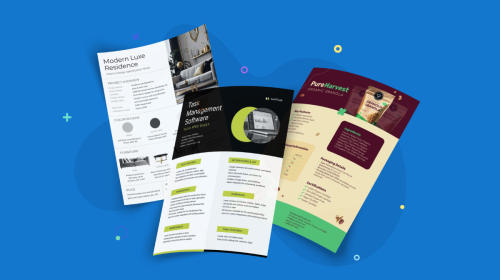
11 SBAR Templates for Effective Communication: How to Use Them + Top Tips


If you're in a high-risk profession and often face difficulty articulating critical information, you'll find the SBAR framework helpful.
SBAR stands for Situation, Background, Assessment and Recommendation. It's a structured format to quickly, accurately and coherently convey critical information even under pressure.
The SBAR framework makes it easier for the receiver to understand essential points rapidly, minimizing errors and improving decision-making.
Wondering how to use this framework to improve team communication? We’ve got you covered.
In this article, we'll show you 11 SBAR templates you can customize right away, guide you on how to fill them and share best practices to help you use them effectively.
Let's go!
Disclaimer: Visme is not a HIPAA-compliant platform and should not be used to store, process, or transmit protected health information (PHI). Users are responsible for ensuring their use of Visme complies with applicable data privacy and security regulations.
SBAR is a simple communication tool that helps deliver critical information clearly and succinctly in written or verbal form. The United States military initially developed it in the 1940s for use in nuclear submarines and other situations where communication can have a life-or-death consequence.
It's been so successful that the healthcare industry has adopted it too. For instance, Kaiser Permanente adopted SBAR in 2002 to support its quick reaction teams in their investigations and to guarantee patient safety.
What is the SBAR format? Here's an example below that show how each letter of the SBAR acronym prompts you to answer the following questions:
Made with Visme Infographic Maker
An SBAR template is a pre-designed, editable document that guides and shows how to share information using the SBAR framework.
For example, the physician SBAR template shows how physicians can communicate critical patient information, especially during handoffs, consultations or emergencies.
The beauty of using a template is that the design is sorted and the components of the SBAR framework are already laid out.
All you have to do is customize it to streamline communication across different scenarios in your organization or project.
With Visme’s professionally designed SBAR templates, you're well on your way to more effective professional communication.
If you're wondering, "Is SBAR still used?" the answer is a resounding yes. Many people, not just in the medical field, use SBAR for project management and communication. Having a template on hand can make that experience easier and smoother.
SBAR is a simple framework, but it can take time to master if you're not accustomed to concise and structured communication. However, when paired with teaching sessions and visual aids, a study from the Future Health Journal found that 100% of nursing staff became aware of SBAR protocols and reported a 44% average improvement in their perceived effectiveness of telephone handovers.
SBAR templates offer a visual aid that helps you remember key components and provide prompts that guide you on what information to include and how to structure them.
The Joint Commission International reports that improper communication during handovers accounts for 80% of serious medical errors, including delayed treatment, incorrect medication, wrong surgeries and more.
Medical teams can minimize these errors with standardized SBAR templates.
Using templates ensures that information providers deliver accurate information consistently and helps receivers become familiar with the expected content and layout. This reduces misunderstandings, improves patient safety and enhances overall communication efficiency.
Imagine a company where employees spend hours creating lengthy situation reports and engaging in extensive back-and-forth to clarify ambiguous details. According to Grammarly, this inefficiency costs companies approximately $12,000 per employee annually.
Ready-to-use SBAR templates provide a structured format that keeps you focused on the important details. This reduces the time spent organizing and filtering information, allowing for quicker and clearer conversations between parties.
The SBAR framework encourages team members to make recommendations, which can be challenging, especially for those new to the framework or during inter-team collaboration. Using a template as a guide can boost team members’ confidence, spark creativity and improve collaborative communication.
Below is an SBAR example shared by Dr. Rey Marrero as he shows how to clearly communicate a critical change in a patient’s condition and suggest next steps to support quick decision-making.
"As a doctor, I can tell you firsthand how critical clear and concise communication is in healthcare. That’s why I highly recommend the SBAR method (Situation, Background, Assessment, Recommendation) for nurses when communicating with physicians. It’s a simple, effective tool that ensures all the relevant details are presented in a structured way, allowing doctors to quickly understand the situation and make informed decisions" - Rey Marrero, MD

The handoff process in healthcare is very crucial in ensuring that a patient's care continues seamlessly. With this one-page template, you can easily pass on the patient’s condition, history, current status and necessary actions for a smooth continuation of the patient’s care. A great template for using an SBAR in nursing. Customize this template to maintain a consistent brand identity across all your documents using Visme's brand design tool.

This SBAR website traffic report template is the perfect tool for sharing a comprehensive overview of your company's website traffic with stakeholders and team members.
It starts with a brief snapshot of your current website traffic situation. Then, dive into the background section to paint a complete picture of the factors impacting your website traffic.
Instead of boring text, this template uses charts and graphs to share insights about traffic sources, user behavior, and other important patterns that are shaping your website traffic. It also doubles as an sbar form for marketing, content and SEO.
Customize the template in the Visme editor by replacing the placeholder data with your own. If the chart type doesn't meet your needs, feel free to change it to any of the 20+ types of charts and graphs, including gauge charts, bubble charts, area charts, funnel charts and more.
Aside from reporting website traffic, you can use this template to create any business reports, including research and annual reports, especially when they require data and stats breakdown.

As a project manager, keeping clients informed about project status is crucial for maintaining transparency. Use this template to present your project reports in a structured format so that stakeholders can quickly understand the key points.
This free free sbar template comes with an impressive layout, stunning images and a flipbook effect to keep the readers engaged.
Like every other SBAR template, this template starts with the situation section, which provides a quick highlight of the project’s scope. Then, it dives into the project background, including the company’s offerings, performance, competitors and more.
Further into the template, you’ll find the assessment page, which gives a clear breakdown of the project’s results and recommendations.
You can import custom images or choose from Visme’s vast library of high-resolution stock photos to improve the emotional impact of your information.
Alternatively, get creative with Visme's AI image generator. Simply describe your desired image and watch it generate unique, high-quality images in seconds. Visme’s AI image editor also comes in handy if you’re uploading your own images and need to polish them to perfectly match your needs.
This template not only allows you to communicate effectively with stakeholders but also showcases the creativity and hard work you’ve poured into your product. With its flippable format and captivating visuals, the template emphasizes the beauty and versatility of your product.
Using the Situation, Background, Assessment and Recommendation (SBAR) framework, product managers can systematically highlight issues, identify root causes and propose actionable solutions.
Take advantage of the graph, chart and table-rich assessment page to showcase and break down key performance metrics such as the cost of product development, sales, returns, customer feedback and more.
With recommendations that align with the assessment insights, you can empower them to take profitable actions quickly.
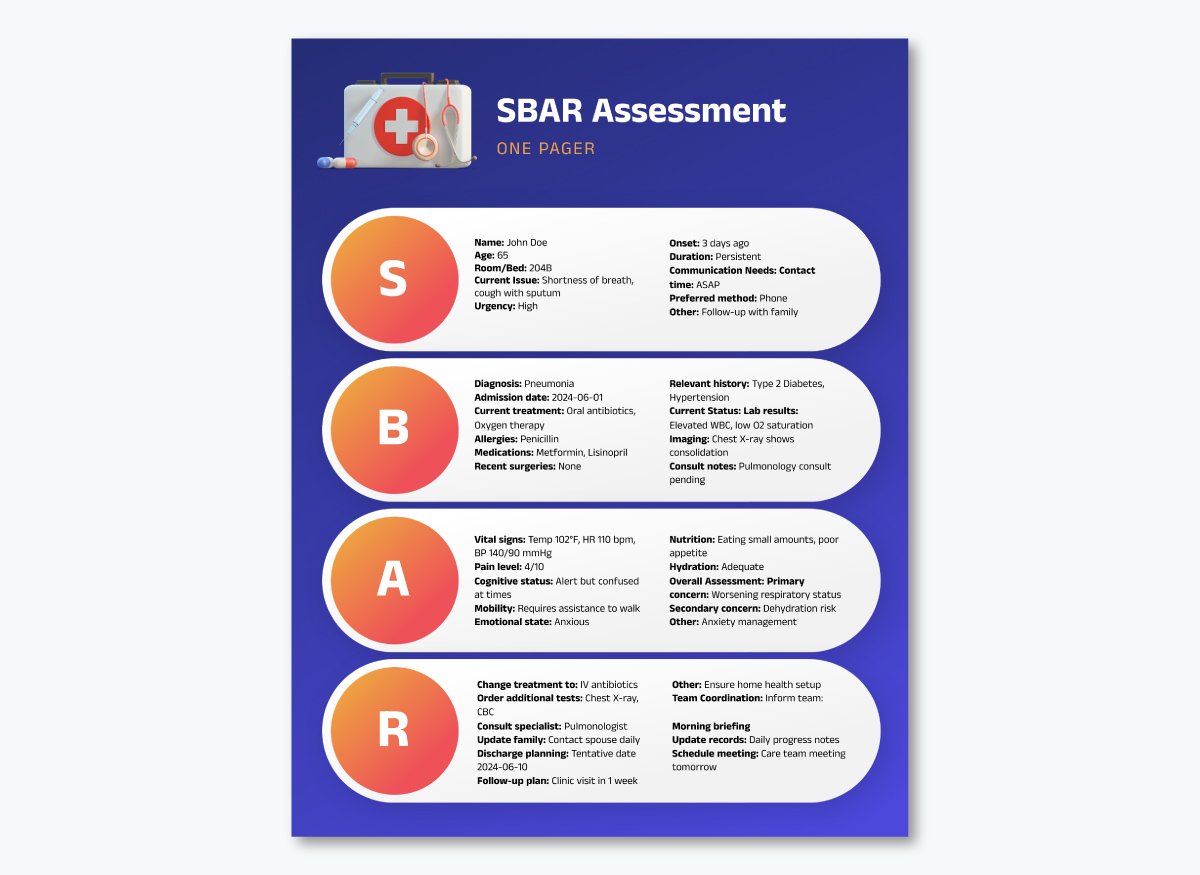
Use this SBAR assessment template to gather and interpret information about a patient's health status, identify medical issues and develop a treatment and care plan.
The template itemizes the patient's information, making it easier for the reader to skim and digest the details. This easy-to-understand format will aid swift responses during transfers between departments or facilities. Replace the placeholder text and then edit the visual elements until you’re satisfied with the look and feel.
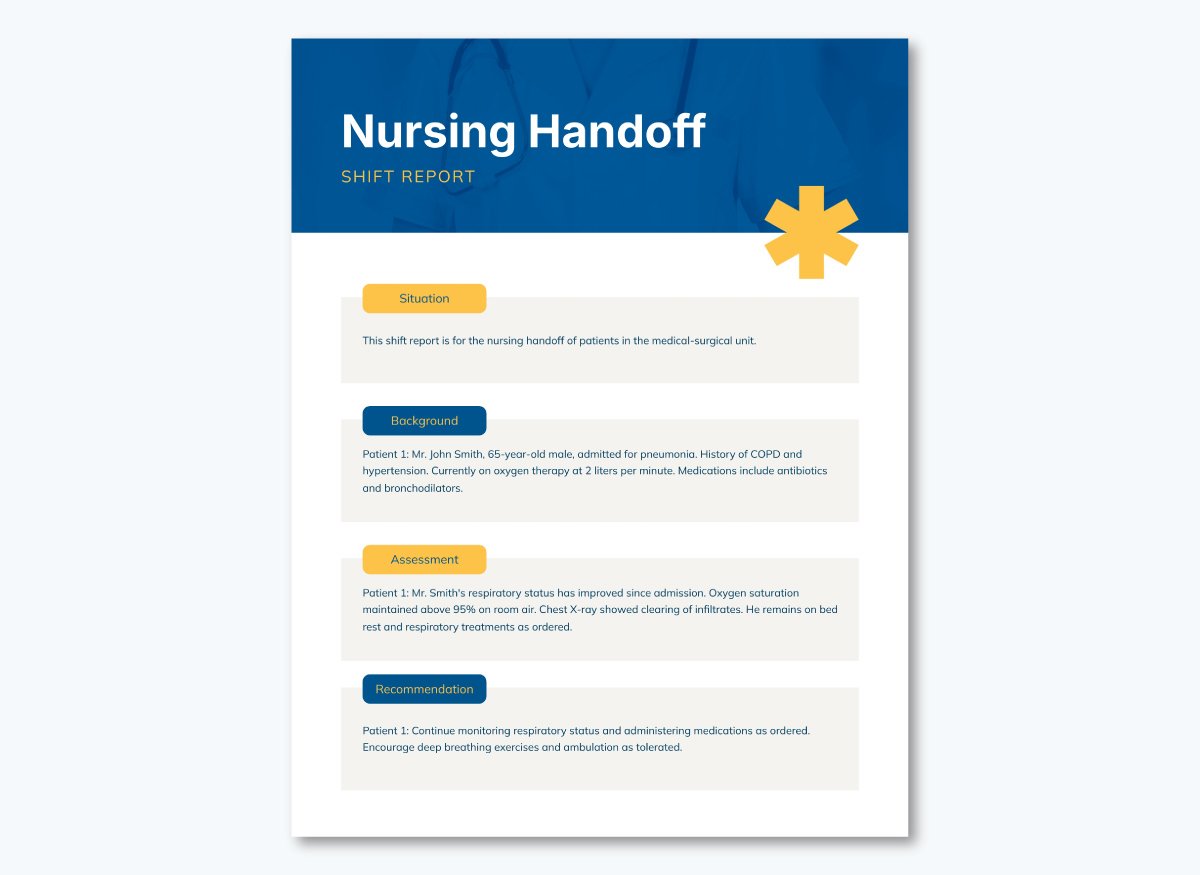
With this shift report template, nurses can give concise patient information about a patient’s current status, recent changes, ongoing needs and more to the incoming healthcare provider.
The design is clean and easy to follow, with an eye-catching color scheme. If you need to include additional documents or details in your shift report for better context, you can easily link them using Visme’s interactive features.

This physician SBAR template helps doctors deliver a clear, structured summary of a patient’s exam when consulting with specialists or care teams. It’s a strong SBAR report example your staff can reference when completing your SBAR layout.
Healthcare institutions also need it to facilitate rapid and effective communication of a patient's health status in urgent situations, so they can intervene quickly.
Visme allows you to publish and share your SBAR templates by downloading them as high-quality PDF, PNG or JPEG images. This way, you can print them out for quick access. Alternatively, share a private link with your healthcare team to view or comment on the SBAR report.

Communicate critical information about medication-related issues, such as medication orders and patient responses to drugs, using this simple pharmacy template. The template features simple aesthetics and a well-organized layout that emphasizes key sections.
Use Visme’s collaborative feature to invite other pharmacists and healthcare professionals to view the information and leave comments, enhancing teamwork and feedback. Visme’s workflow feature can also help in assigning specific tasks regarding a patient's medication and treatment plan ensuring that everyone is on the same page.


Want an SBAR template that stands out for your pediatrics department? Use this specially designed pediatric SBAR template.
This pediatric SBAR template helps you develop and communicate care plans by summarizing the child’s current status, history, symptoms and recommended interventions.
There is ample white space and a perfectly blended color combination. Feel free to customize with your own colors, fonts, logo, and other brand elements
You can quickly access any feature or design element you need with Visme Shortcuts. Simply press the forward-slash (“/”) key on your keyboard to bring up a search bar. Then type in the features or design elements you need into the search bar.
This SBAR template simplifies communication about a patient’s condition and care needs. It helps the health care team—nurses, doctors and specialists—in charge of a patient's case communicate effectively and ensures everyone is aligned with the patient’s care protocol.
The template features vibrant two-tone color blocks to help keep the reader focused on one segment at a time.
Every design element in this template is customizable. You can swap content, colors, font and logo to match your branding.
Help your nursing team give a clear picture of their patient's condition and needs with this professional nursing SBAR template. You’ll find distinct sections to detail the client’s situation, background, assessment and recommendations.
Customize this template with your hospital and patient information using Visme's dynamic field feature. It automatically fills in or updates specific details across all documents, reducing the risk of manual entry errors.
For example, updating the patient ward number in the dynamic field will change it across all SBAR information and other documents containing that field.
Disclaimer: Visme is not a HIPAA-compliant platform and should not be used to store, process, or transmit protected health information (PHI). Users are responsible for ensuring their use of Visme complies with applicable data privacy and security regulations.
Writing an effective SBAR requires more than just filling out the four sections—it demands strategic thinking and careful preparation. Here's my step-by-step approach to crafting SBARs that get results:
This section provides a clear and concise description of the current issue or reason for communication. Aim to communicate the information in no more than 30 seconds or one short paragraph.
In healthcare, this section should:
For example, This is Dr. Arwan Ali, the attending physician for Stewart Mike, a 65-year-old male admitted with pneumonia. Mr. Mike is experiencing increased shortness of breath and a drop in oxygen saturation of 88% on room air.

In a business context, it might be: "Our project to launch the new product line is behind schedule by three weeks due to delays in supplier deliveries."
Provide essential details that led to the current situation, including significant changes, decisions or conditions. This section can easily become long-winded, especially with patients who have extensive medical histories. To ensure conciseness, keep every detail relevant to the previously described situation.
For instance, if Mr. Mike is an amputee, this detail is likely unnecessary in understanding his current shortness of breath case. Instead, focus on relevant information such as his primary diagnosis and any contributing secondary conditions: "Mr. Mike was admitted three days ago with pneumonia and has been receiving IV antibiotics. He also has a history of COPD and is on bronchodilators."

In business scenarios, describe events or factors leading to the issue. For example: "The delay began when our primary supplier experienced a major equipment failure, halting production for two weeks. Several key team members were out sick, which further impacted progress."
This section details your analysis or observations of the situation. It should cover patterns, trends, actions taken, impacts and results. In a clinical context, this includes details like vital signs, changes in the patient’s condition, new symptoms and relevant lab results or imaging findings.
For example: "His vital signs show a heart rate of 110 bpm, a respiratory rate of 28 breaths per minute and a blood pressure of 140/90 mmHg. He has diminished breath sounds in the lower lobes bilaterally and is coughing up thick, yellow sputum."
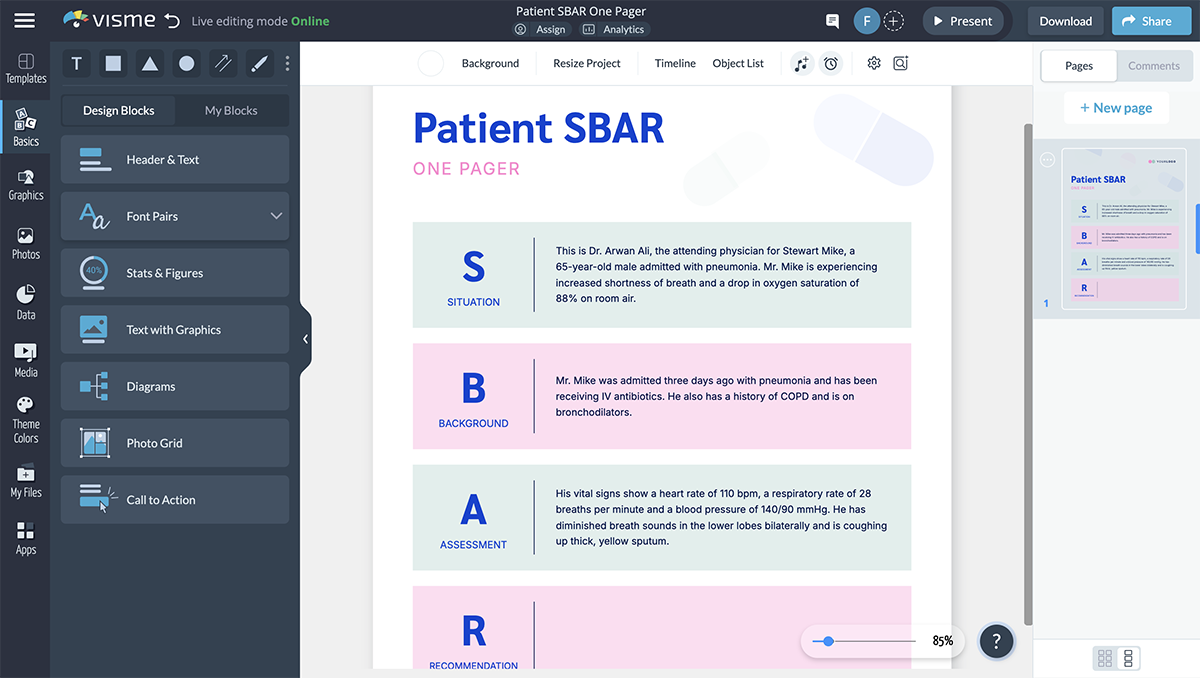
In a business context: "The delay has created a bottleneck in our production schedule, impacting our ability to meet the initial launch date. This will likely result in missed revenue targets and could affect our market competitiveness."
Again, avoid including unrelated findings that do not directly pertain to the current situation.
Offer specific, actionable recommendations to address the issue. Be clear and concise about what actions should be taken and indicate the urgency of the expected response.
In Mr. Mike's case, this could be: "I recommend starting supplemental oxygen at 2 L/min via nasal cannula and obtaining a chest X-ray to rule out a worsening infection. Please review his condition within the next hour."
The delayed product launch recommendation could be: "To mitigate these issues, I recommend outsourcing a portion of the production to an alternative supplier temporarily. Also, we should allocate extra resources to the project team to accelerate the remaining tasks and recover lost time.”
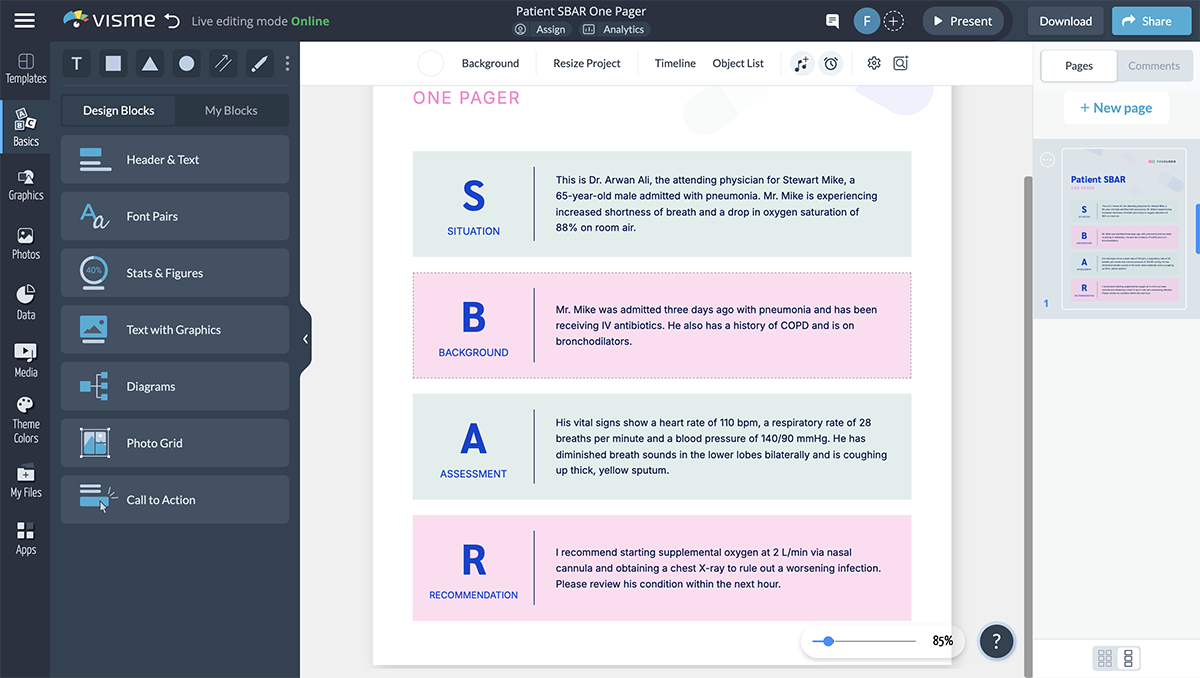
Note: A recommendation doesn't mean you need to know exactly what to do next, especially if you’re not highly experienced: it could simply involve asking for assistance or further guidance.
Review the patient's records to ensure you have accurate and comprehensive information.
Reach out to colleagues whose insights or opinions may help you provide more valuable information. Also, ensure that you’re not requesting something impossible to do currently or proposing an already implemented solution.
Having a thorough knowledge of the case is important for determining the most relevant points without being long-winded. Therefore, assess the situation yourself, identify the primary issue and ensure you understand the context and background.
Stick to the SBAR format—Situation, Background, Assessment, Recommendation. Avoid mixing information across sections, as this can cause incoherence; ensure each section is clear and complete before moving to the next.
When filling each section, start with the most critical and relevant information. For example, in the Background section, present the primary cause or history first. Do the same with Assessment and Recommendation. This approach helps the reader prioritize urgent and important details.
It's tough to be concise when there's a lot of info, but not all relevant details need to be in the SBAR report.
Prioritize key points and present them in an easy-to-understand manner. This empowers the receiver to ask relevant questions if needed.
After the communication, follow up with the team to verify that the situation has been addressed. Record the communication and any subsequent actions in the patient’s file.
Review the communication for any areas of improvement. Consider feedback from colleagues on the clarity and effectiveness of your SBAR.
SBAR is important for providing a clear, structured format for communication, which helps reduce misunderstandings and improves decision-making in critical situations.
An SBAR report is a structured communication tool for conveying critical information clearly and concisely.
SBAR in healthcare is a tool that helps to standardize communication in clinical settings, especially during handoffs, emergencies or consultations, to ensure quick patient response and improved safety.
Situation: Dr. Luke is calling about Mr. Stone Jones, who is experiencing severe chest pain.
Background: Mr. Jones has a history of hypertension and was admitted yesterday with a suspected heart attack.
Assessment: His chest pain has worsened, his blood pressure is 160/100 and he is experiencing shortness of breath.
Recommendation: Perform an urgent ECG and contact the cardiology team immediately.
A nurse should use SBAR when communicating critical patient information during handoffs, reporting changes in patient status, consulting with other healthcare professionals or addressing urgent issues.
SBAR is not universally mandatory, but it is highly recommended and widely adopted in many healthcare settings for its effectiveness in improving communication and patient safety.
SBAR templates are not only used in clinical settings. They can be applied in various fields such as business, aviation, emergency services and more, wherever clear and structured communication is essential.
You can make a standard SBAR template using Visme. Either build one from scratch or choose from our library of professionally designed templates. Each comes highly customizable and saves you time and effort in the long run.
With the SBAR framework, you can deliver just the right amount of information to help your team members understand a situation and make informed decisions.
And while it may be challenging to get started with the framework, pre-made templates can make it very seamless. Use Visme's SBAR templates as a guide and customize them to fit your specific needs.
Visme also offers a wide range of features that simplify creating and editing documents, even without prior design experience. You can produce on-brand documents, incorporate interactive icons, charts and graphs and explore creative possibilities with the AI writer, document generator, image generator and editor.
With Visme, the possibilities are endless. Sign up for an account today to start making your team communication more efficient and effective.
Design visual brand experiences for your business whether you are a seasoned designer or a total novice.
Try Visme for free